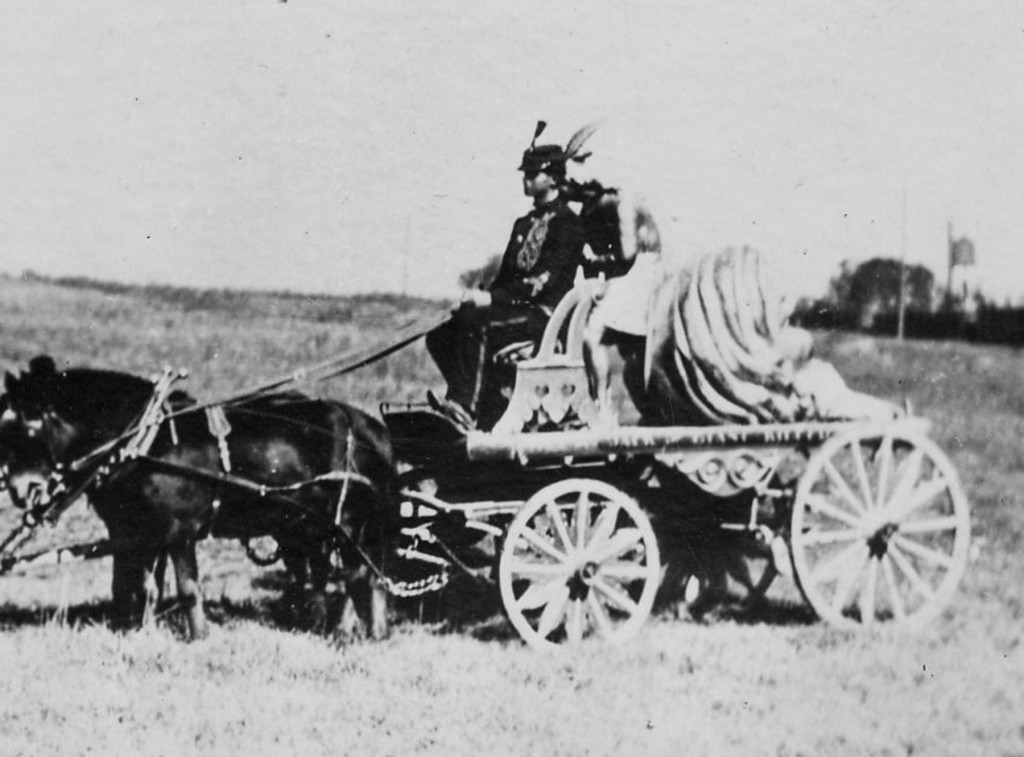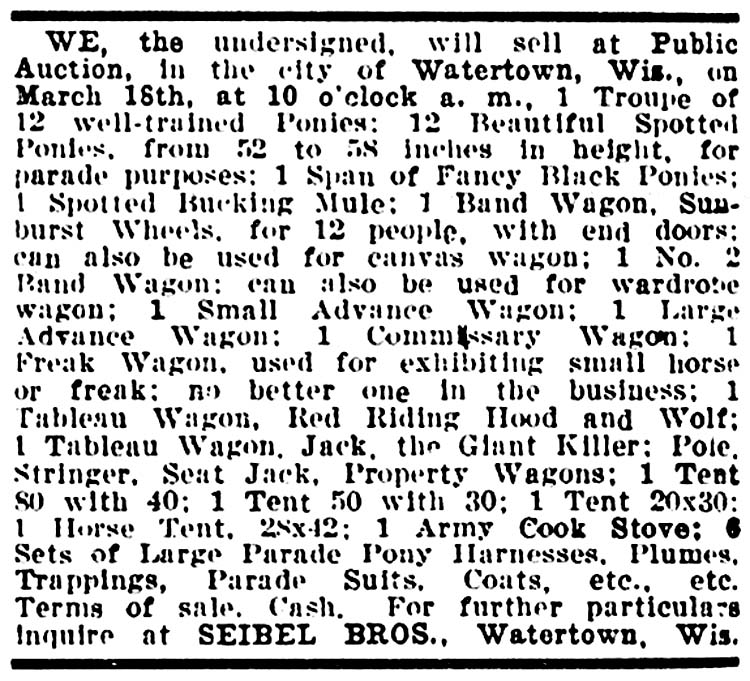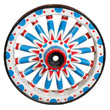Jack, the Giant Killer – a pony float
by Richard Conover
(1) THE JOHN ROBINSON SET
Not to be outdone, the John Robinson Show had a pair of floats in 1872, representing both Titania and her spouse – one being pulled by a 16-pony hitch, and the other, by a string of eight. Because of the overlapping of dates, neither of these could have been bought off the Great European. Either of them could have been the one that possibly was made from the top of the Golden Horse Bandwagon (ref: THE TELESCOPING TABLEAUS, pages 2 and 3). At least, no references have yet been found that would prove that the wagon remained intact after 1869, which would discredit the story about its being disassembled. The Robinson Show evidently had groups of these floats at two different times. The first group may have originated as early as 1865 if any credulousness can be allowed the show’s advertisement in a St. Louis newspaper. The evidence does not begin to become conclusive until 1872 with the information related above from a Cincinnati paper. This is further substantiated by on 1875 account from Columbus Ohio, where the number in the group was placed at four.
According to a news item in an 1889 Clipper, a new set was being built for the show by a Cincinnati wagon builder. The show’s 1891 courier identified these by name as Cinderella, Red Riding Hood, Old Woman in the Shoe, Aladdin, and Sinbad the Sailor.
“NOTES PROM THE JOHN ROBINSON SHOW . —Chas. Gebest, band leader , has added six pieces to the band . Three new thoroughbred running stallions recently arrived for the hippodrome. Madames McCarthy, Watkins, Chevlnan, female jockey and race riders, came 18 . Two racing camels also came 16 . The giraffe is being broken to drive, and probably will be put in the races 20. Two water buffalos , driven by Zulus, are among the new attractions in the hippodrome . So far the ostriches refuse to be driven, but eventually will break all rigbt. Business week of 13 was one of the best the show ever had. We soon will have the six new nursery rhyme chariots, which are being built at Cincinnati. The future look out for tbe show is good . Everybody is well, and looks each week ( for the old reliable Clipper, the only show paper.” – NY Clipper, June 8, 1889, page 207.
By way of confirmation, the Louisville paper commented that the parade was tailed by “. . . diminutive chariots almost without end.” Among the items offered by Robinson in a large surplus property sale advertised in the Clipper for December 3, 1892, were a calliope, a giraffe, and five pony floats, namely, Cinderella, Jack the Giant Killer, Robinson Crusoe, Liberty, and St. George and the Dragon. Since only one of those on the sale list (Cinderella) agreed with the 1891 courier list, we might be correct in assuming that the show had a total of nine. At least, this conjecture would fit into my next hypothesis which, while being the most explainable of any of the possible transfers, is admittedly without sufficient proof.
 ( This is close-up cropped from the Trimpy negatives taken on Ringling Bros. in 1900 that Bill Kasiska had – Conover collection )
( This is close-up cropped from the Trimpy negatives taken on Ringling Bros. in 1900 that Bill Kasiska had – Conover collection )
THE RINGLING BROS. SET
According to information published by the Ringlings in their composite route book (1882-1914), they purchased the giraffe and the calliope from the Robinson ad. Since the Ringling Show had a Robinson Crusoe, a Red Riding Hood and a Jack the Giant Killer, as evidenced by the photographs (nos. 2, 3, and 4) supposedly taken in 1900, it is possible that these may also have been acquired at the Robinson sale. However, all of the photographic coverage that we have of the Ringling floats only span the years 1900 to 1901, a situation that would tend to discount the probability of this particular transaction. It would be less of a conjecture to assume that the Red Riding Hood and Jack the Giant Killer offered for sale by Seibel Brothers of Watertown, Wisconsin, in a March, 1904, Billboard ad were ex-Ringling equipment.
 ( Billboard, March 12, 1904, page 22 )
( Billboard, March 12, 1904, page 22 )
No further evidence was ever found to know who bought this from the Seibel Bros. sale or what happened to it after this 1904 ad.
(1) “Those Diminutive Tableaus, the Allegorical Pony-Drawn Parade Floats” – Bandwagon, Vol. 4, No. 5 (Sep-Oct), 1960, pp. 3-9
If you have any questions or have more photographic evidence, feel free to contact us at circuswagons@gmail.com
